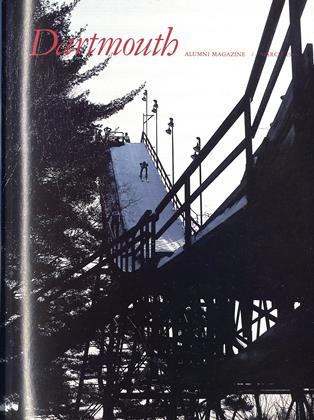The making of Dartmouth: A Visual Remembrance (Foremost Publishers, 1982) which was conceived and financially backed by Russell Boss '61, gave Photographer George Robinson of Jericho, Vt., and Publisher James Patrick some experiences not readily forgotten.
About his job of taking the color photographs, Robinson recalls:.
"I shot about 10,000 photos in ten months. It's a 200-mile round trip and I made at least 65 trips for about 13,000 miles. I camped in the summer and rented a caretaker's cabin with a wood stove in winter, and sometimes I drove back home each day. The most unusual experience was being hit with two raw eggs at the chariot race, in the first hour of the assignment. I was at the right place at the wrong time. Then having them try to throw me into a pool with my cameras on, at a frat party. They have a strange way of showing they like you.
"I was drenched at the first three football games and at the bonfires. It almost rained at graduation. Students would ask me the same question over and over: 'How can you do a book on Dartmouth if you didn't go here?'
"Sometimes bad luck turned good. Examples: balloons that wouldn't fly (p. 27), trout that wouldn't be caught (p. 47), hikers that never appeared when there was fog (p. 133), and when they did arrive, no fog (p. 34). The weather would never cooperate. It would always change from the time I left Vermont until I reached Dartmouth, so I learned to leave home when it looked miserable rain in Vermont but beautiful fog in Hanover (cover and p. 120)."
Publisher Patrick had the job of seeing the book through the press in Japan. His recollections are different but equally vivid:
"I lived (Japanese style on the floor) at the printing plant that was one hour from Tokyo in farm country, while okaying each printing form as it came off the press. The schedule was quite hectic; there was a press okay every 1½ hours, 24 hours a day for 10 days. This schedule after an 18-hour jet lag was most brutal.
'Hot water for shaving and showering was turned on between 7:00 a.m. and 8:00 a.m. only. Breakfast of rice and raw eggs in the cafeteria was also available only between 7:00 a.m. and 8:00 a.m. On some days a press okay fell during this hour and it was necessary to show up at the press fully lathered, sandled, and wrapped in a bath towel. Needless to say, there were quite a few snickers from my Japanese hosts, not one of whom could understand English. Sign language was my only form of communication.
"With no restaurants in this rural area and without transportation available, I had to visit local farmers' fruit and vegetable stands to buy lunch and dinner. I spent an average of $ 1.39 a day on meals. I lost 9 lbs. The Japanese raise superb vegetables, which are quite cheap outside of the large cities. When I finished and returned to Tokyo, I headed for the best restaurant and the best steak dinner money could buy.
"The craftmanship of the Japanese printers is superb. And they are meticulously neat and clean. Just visualize 200 pressmen ending their 12-hour shifts scrubbing their feet before going home to shower."
 View Full Issue
View Full Issue
More From This Issue
-
 Feature
FeatureWhat Is Success?
March 1983 By E. R. (Skip) Sturman '70 -
 Feature
Feature"Long John" Wentworth, 1836
March 1983 By Dirk Olin '81 -
 Feature
FeatureYou know, what's his name . . ."
March 1983 By Nardi Reeder Campion -
 Feature
FeatureOff and Chopping
March 1983 By Jean Hanff Korelitz -
 Article
ArticleSetting the Record Straight: A Senior-Year Perspective
March 1983 By Libby Schmeltzer '83 -
 Sports
SportsSports
March 1983 By Brad Hills '65







